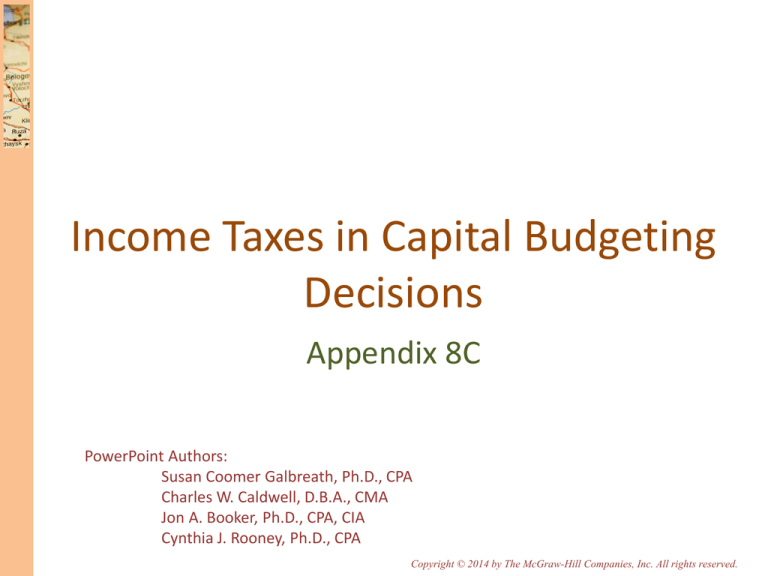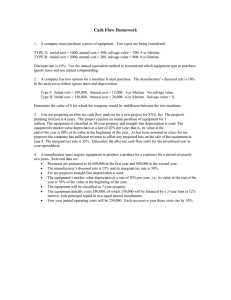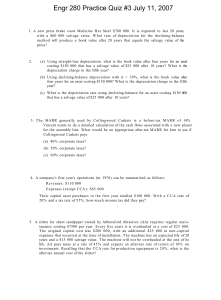
Income Taxes in Capital Budgeting
Decisions
Appendix 8C
PowerPoint Authors:
Susan Coomer Galbreath, Ph.D., CPA
Charles W. Caldwell, D.B.A., CMA
Jon A. Booker, Ph.D., CPA, CIA
Cynthia J. Rooney, Ph.D., CPA
Copyright © 2014 by The McGraw-Hill Companies, Inc. All rights reserved.
8C-2
Learning Objective 8-8
(Appendix 8C)
Include income taxes in
a capital budgeting
analysis.
8C-3
Simplifying Assumptions
Taxable income
equals net income as
computed for
financial reports.
The tax rate is a
flat percentage of
taxable income.
8C-4
Concept of After-tax Cost
An expenditure net of its tax effect is known
as after-tax cost.
Here is the equation for determining the
after-tax cost of any tax-deductible cash
expense:
After-tax cost
=
(net cash outflow)
(1 - Tax rate)Tax-deductible cash expense
8C-5
After-tax Cost – An Example
Assume a company with a 30% tax rate is
contemplating investing in a training program
that will cost $60,000 per year.
We can use this equation to determine that the
after-tax cost of the training program is
$42,000.
After-tax cost
= (1 - Tax rate)Tax-deductible cash expense
(net cash outflow)
$42,000 = (1 - .30)$60,000
8C-6
After-tax Cost – An Example
The answer can also be determined by
calculating the taxable income and income tax
for two alternatives—without the training
program and with the training program.
The after-tax cost of
the training program is
the same—$42,000.
8C-7
After-tax Cost – An Example
The amount of net cash inflow
realized from a taxable cash
receipt after income tax effects
have been considered is known
as the after-tax benefit.
After-tax benefit
=
(net cash inflow)
(1 - Tax rate) Taxable cash receipt
8C-8
Depreciation Tax Shield
While depreciation is not a cash
flow, it does affect the taxes that
must be paid and therefore has
an indirect effect on a
company’s cash flows.
Tax savings from
the depreciation = Tax rate Depreciation deduction
tax shield
8C-9
Depreciation Tax Shield – An Example
Assume a company has annual cash sales and
cash operating expenses of $500,000 and
$310,000, respectively; a depreciable asset,
with no salvage value, on which the annual
straight-line depreciation expense is $90,000;
and a 30% tax rate.
Tax savings from
the depreciation
tax shield
$27,000
=
=
Tax rate Depreciation deduction
.30 $90,000
8C-10
Depreciation Tax Shield – An Example
Assume a company has annual cash sales and
cash operating expenses of $500,000 and
$310,000, respectively; a depreciable asset,
with no salvage value, on which the annual
straight-line depreciation expense is $90,000;
and a 30% tax rate.
Tax savings from
the depreciation
tax shield
$27,000
=
=
Tax rate Depreciation deduction
.30 $90,000
The depreciation tax shield is $27,000.
8C-11
Depreciation Tax Shield – An Example
The answer can also be determined by
calculating the taxable income and income tax
for two alternatives—without the depreciation
deduction and with the depreciation deduction.
The depreciation tax
shield is the same—
$27,000.
8C-12
Holland Company – An Example
Holland Company owns the mineral
rights to land that has a deposit of
ore. The company is deciding
whether to purchase equipment and
open a mine on the property. The
mine would be depleted and closed
in 10 years and the equipment would
be sold for its salvage value.
More information is provided on the next slide.
8C-13
Holland Company – An Example
Cost of equipment
Working capital needed
Estimated annual cash
receipts from ore sales
Estimated annual cash
expenses for mining ore
Cost of road repairs
needed in 6 years
Salvage value of the
equipment in 10 years
After-tax cost of capital
Tax rate
$
$
300,000
75,000
$
250,000
$
170,000
$
40,000
$
100,000
12%
30%
Should
Holland open
a mine on the
property?
8C-14
Holland Company – An Example
Step One: Compute the annual net cash
receipts from operating the mine.
Cash receipts from ore sales
Less cash expenses for mining ore
Net cash receipts
$
$
250,000
170,000
80,000
8C-15
Holland Company – An Example
Step Two: Identify all relevant cash
flows as shown.
Holland Company
(1)
(2)
Items and Computations
Cost of new equipment
Working capital needed
Annual net cash receipts
Road repairs
Annual depreciation deductions
Salvage value of equipment
Release of working capital
Net present value
Year
Now
Now
1-10
6
1-10
10
10
Amount
$ (300,000)
$ (75,000)
$ 80,000
$ (40,000)
$ 30,000
$ 100,000
$ 75,000
8C-16
Holland Company – An Example
Step Three: Translate the relevant cash
flows to after-tax cash flows as shown.
(1)
Items and Computations
Cost of new equipment
Working capital needed
Annual net cash receipts
Road repairs
Annual depreciation deductions
Salvage value of equipment
Release of working capital
Net present value
Year
Now
Now
1-10
6
1-10
10
10
Holland Company
(2)
(3)
Tax
Effect
Amount (1) (2)
$ (300,000)
0
$ (75,000)
0
$ 80,000 1-.30
$ (40,000) 1-.30
$ 30,000
.30
$ 100,000 1-.30
$ 75,000
0
(4)
After-Tax Cash
Flows
$
(300,000)
$
(75,000)
$
56,000
$
(28,000)
$
9,000
$
70,000
$
75,000
8C-17
Holland Company – An Example
Step Four: Discount all cash flows to
their present value as shown.
(1)
Items and Computations
Cost of new equipment
Working capital needed
Annual net cash receipts
Road repairs
Annual depreciation deductions
Salvage value of equipment
Release of working capital
Net present value
Year
Now
Now
1-10
6
1-10
10
10
Holland Company
(2)
(3)
(4)
(5)
(6)
Tax
Effect
After-Tax Cash
Amount (1) (2)
Flows
12% Factor Present Value
$ (300,000)
0
$
(300,000)
1.000 $
(300,000)
$ (75,000)
0
$
(75,000)
1.000
(75,000)
$
80,000
1-.30 $
56,000
5.650
316,400
$ (40,000) 1-.30 $
(28,000)
0.507
(14,196)
$
30,000
.30
$
9,000
5.650
50,850
$ 100,000 1-.30 $
70,000
0.322
22,540
$
75,000
0
$
75,000
0.322
24,150
$
24,744
8C-18
End of Appendix 8C







